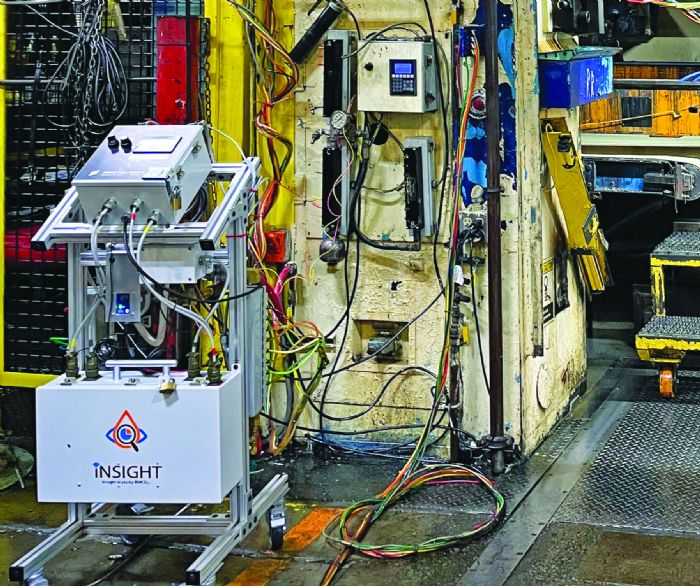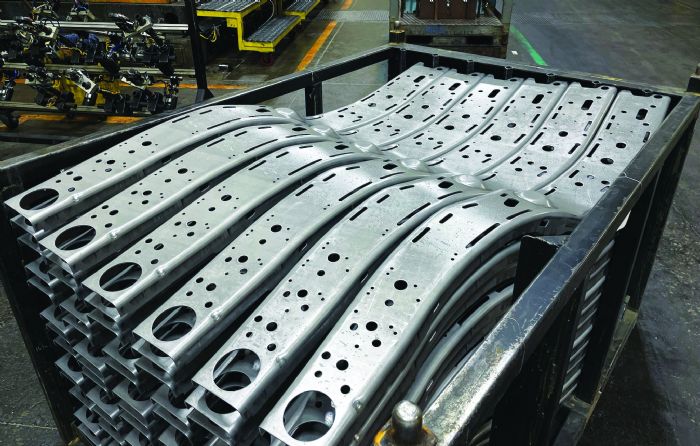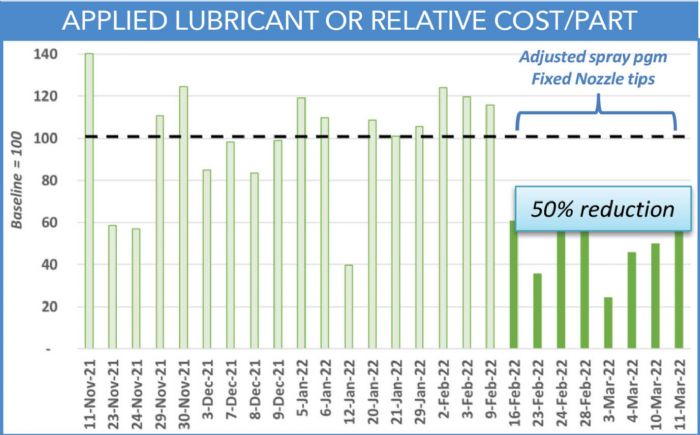At Irmco’s disposal to bring such data collection to the Metalsa pressroom: its patented iNSight system, developed by Kenny and Irmco production and facility manager Steve Glowacz. It’s designed to track lubricant volume delivered per stroke; parts stamped per gallon; and, ultimately, lubricant cost per part. The system senses and sends alerts when production stops or when concentration or mixing changes beyond spec; identifies changes in process settings or variables from one shift to another; and allows shops to compare before-and-after modifications to processes to validate process-improvement activities.
To develop iNSight, Irmco modified a cart-mounted high-pressure lubricant-spray system (a Spra-Rite from Industrial Innovations), adding an electronics package for data logging as well as sensors to monitor flow, concentration and pressure. A cellphone modem enables the setup to send out data alerts.
The Patient: A 2500-Ton Transfer Press
 “We had Irmco install the iNSight system on a 2500-ton coil-fed transfer press,” Struckmeyer shares, “outfitted with 24 manifold inputs—16 on the top die section and eight underneath. We used iNSight only for monitoring the top manifolds. We run two 10-ft. dies on that press and, depending on the part and process, will spray lubricant in the first die for blanking and the second die set for forming.”
“We had Irmco install the iNSight system on a 2500-ton coil-fed transfer press,” Struckmeyer shares, “outfitted with 24 manifold inputs—16 on the top die section and eight underneath. We used iNSight only for monitoring the top manifolds. We run two 10-ft. dies on that press and, depending on the part and process, will spray lubricant in the first die for blanking and the second die set for forming.”
Lubricant is delivered to the press—and the pressroom’s other presses—from a proportional lubricant and coolant mixing system (an Industrial Innovations’ Pro-Mix). Struckmeyer, describing the outcome of the Irmco project, initiated in mid-2022, notes that one insight gained was that it needed to replace its aging mixing system with a new Pro-Mix, installed later that year—not to improve mixing accuracy but to increase capacity and quicken changeovers.
“While we run only one lubricant throughout the pressroom (an Irmco heavy-duty water-based synthetic), we can use the new Pro-Mix, equipped to provide two different mix ratios, to enable quick changeover between totes and avoid downtime during changeovers,” says Stuckmeyer.
During the 18-wk. trial period with the iNSight system installed on the transfer press, Irmco captured lubricant data in 5-min. slices. As described by Kenny, it monitors three critical measures of the lubrication system’s health: heartbeat (lubricant consumption by stroke); blood sugar (lubricant concentration); and blood pressure (lubricant pressure at the nozzles).
Kenny recalls the most significant discovery of the data-collection exercise: “We were able to show the Metalsa production team very interesting and actionable data on two big runners: left- and right-hand siderails, for which we had identified a significant difference in the amount of lubricant being applied for essentially the same part geometries.”
The Diagnosis
 Reviewing the system health data collected, Kenny and the Metalsa team found that the spray program for one of the parts had been altered, considerably so, leading to an overspray situation. And, after analyzing the data, the production team, upon close investigation of the system components, found that some of the spray-nozzle tips either had been exchanged for larger sizes, or drilled out, presumably to cure clogs. The larger nozzle openings led to overspray.
Reviewing the system health data collected, Kenny and the Metalsa team found that the spray program for one of the parts had been altered, considerably so, leading to an overspray situation. And, after analyzing the data, the production team, upon close investigation of the system components, found that some of the spray-nozzle tips either had been exchanged for larger sizes, or drilled out, presumably to cure clogs. The larger nozzle openings led to overspray.
“But our biggest discovery,” Kenny recalls, “was that some of the parts were being sprayed twice per stroke. Adjusting the process to eliminate the extra spray immediately cut lubricant consumption in half at that die station.”
By eliminating the double-spray and replacing all of the tips with smaller 8001-model tips, Metalsa realized an immediate savings of $20,000.
“We’re definitely using a lot less lubricant,” Struckmeyer says, “yet we have more work to do, including continuing to work on the culture in the pressroom. Next, we’ll turn our attention to a 3000-ton press that employs robotic part transfer and stamps large siderails; it consumes a great deal of lubricant. We’ll be examining the lubricant spray programs, nozzles, etc…and converting from more of a shower-head setup to a fine mist.”
An Epidemic?
Irmco has experienced similar savings opportunities for other iNSight customers, according to company CEO Jeff Jeffery.
“Having applied the iNSight tool at six plants to date, and gathered data on thousands of parts, we have a good feel now for what lubricant consumption should look like based on the application,” he says. “And, we know what the ballpark cost per stroke should be in most cases.
“In general, we see too many stampers not only overspraying—for a variety of reasons, that we can help identify—but also failing to validate their mixtures or using inaccurate mixing equipment,” Jeffery continues. “On average, for the companies we’ve worked with we’ve been able to reduce costs by 20%, and in some cases as much as 50%. That’s how much waste we see in the industry.” MF
See also: IRMCO, Industrial Innovations, Inc.
Technologies: Lubrication
 Brad Kuvin
Brad Kuvin That wake-up call led to the firm’s lubricant supplier, Irmco, suggesting that the plant perform a deep dive into lubricant consumption, by collecting data directly from the plant floor. The project goals: track lubricant consumption per press stroke, while also surveying and validating mixing accuracy and repeatability.
That wake-up call led to the firm’s lubricant supplier, Irmco, suggesting that the plant perform a deep dive into lubricant consumption, by collecting data directly from the plant floor. The project goals: track lubricant consumption per press stroke, while also surveying and validating mixing accuracy and repeatability.





 “We had Irmco install the iNSight system on a 2500-ton coil-fed transfer press,” Struckmeyer shares, “outfitted with 24 manifold inputs—16 on the top die section and eight underneath. We used iNSight only for monitoring the top manifolds. We run two 10-ft. dies on that press and, depending on the part and process, will spray lubricant in the first die for blanking and the second die set for forming.”
“We had Irmco install the iNSight system on a 2500-ton coil-fed transfer press,” Struckmeyer shares, “outfitted with 24 manifold inputs—16 on the top die section and eight underneath. We used iNSight only for monitoring the top manifolds. We run two 10-ft. dies on that press and, depending on the part and process, will spray lubricant in the first die for blanking and the second die set for forming.” Reviewing the system health data collected, Kenny and the Metalsa team found that the spray program for one of the parts had been altered, considerably so, leading to an overspray situation. And, after analyzing the data, the production team, upon close investigation of the system components, found that some of the spray-nozzle tips either had been exchanged for larger sizes, or drilled out, presumably to cure clogs. The larger nozzle openings led to overspray.
Reviewing the system health data collected, Kenny and the Metalsa team found that the spray program for one of the parts had been altered, considerably so, leading to an overspray situation. And, after analyzing the data, the production team, upon close investigation of the system components, found that some of the spray-nozzle tips either had been exchanged for larger sizes, or drilled out, presumably to cure clogs. The larger nozzle openings led to overspray.
